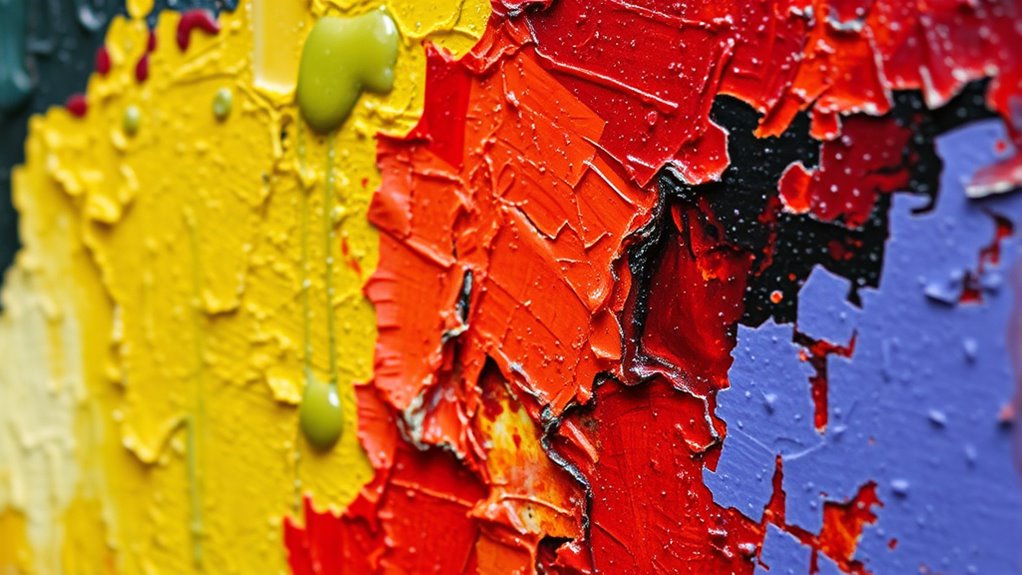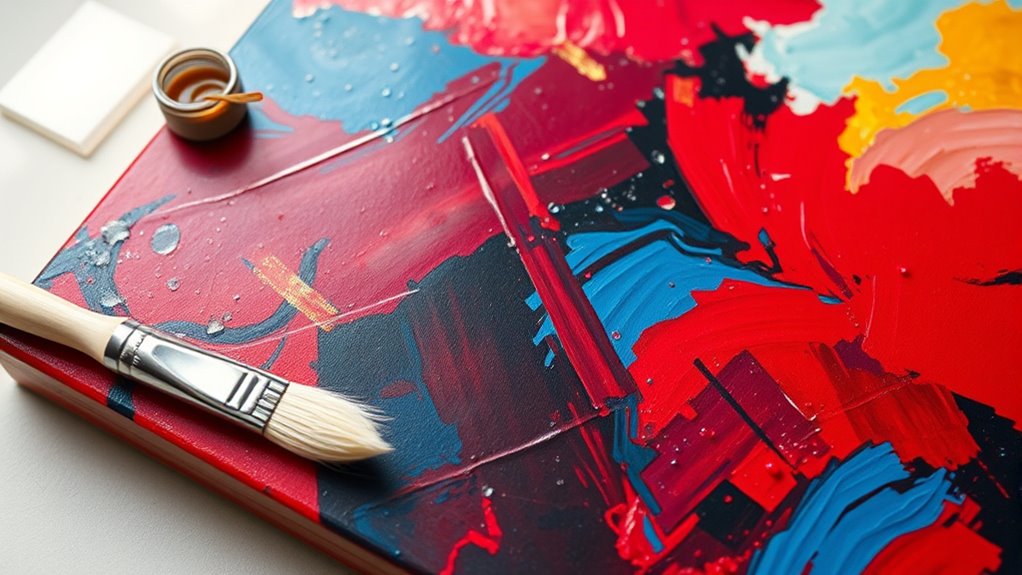Archival varnishes help prevent color fading by forming a protective barrier that shields artwork from harmful UV rays, pollutants, and light exposure. They use high-quality resins and stabilizers to create a clear, durable film that keeps colors vibrant over time. Choosing the right varnish and applying it properly guarantees long-term preservation, safety, and reversibility. If you want to discover more about how these varnishes protect your art effectively, there’s plenty to explore here.
Key Takeaways
- Use archival varnishes with UV filters to block harmful ultraviolet rays that cause color fading.
- Select high-quality, lightfast varnishes tested for durability to ensure long-term color preservation.
- Apply varnish evenly in thin layers, allowing proper drying to prevent bubbles and uneven coverage.
- Regularly inspect and gently clean artwork to remove dust, maintaining optimal protection and appearance.
- Reapply varnish as needed, especially if fading or cracks appear, to restore clarity and ongoing color protection.
What Are Archival Varnishes and Why Are They Important?

Archival varnishes are specially formulated coatings designed to protect artwork and historical objects over the long term. They enhance varnish durability, ensuring your pieces stand the test of time without deterioration. These varnishes serve as a barrier against dust, dirt, UV rays, and environmental pollutants that can cause fading and damage. By applying an archival varnish, you actively support color preservation techniques, helping colors stay vibrant and true to the artist’s original intent. Unlike cheaper alternatives, these varnishes are designed for longevity, maintaining their protective qualities for decades. Knowing which varnish to use can make a significant difference in preserving your artwork’s appearance and value over time. Proper use of archival varnishes is essential for safeguarding your cherished pieces for future generations. Additionally, selecting the right type of protective coating can further enhance the longevity of your artwork’s vibrant colors.
The Composition of Archival Varnishes

Understanding what goes into archival varnishes helps you choose the right protection for your artwork. The formulation mainly includes resins, solvents, and binders, each playing a vital role. Protective additives and stabilizers are also added to enhance durability and prevent deterioration over time.
Components of Varnish Formulation
The formulation of archival varnishes relies on carefully selected components that work together to protect and preserve artworks. These include ingredients that ensure pigment stability, prevent chemical degradation, and maintain clarity over time. High-quality resins form a durable film, while solvents facilitate even application. Chemical preservatives are added to inhibit mold and bacterial growth, extending the varnish’s lifespan. The balance of these elements is critical for effective protection without compromising the artwork’s appearance. Additionally, selecting materials compatible with different types of pigments helps prevent unwanted reactions that could lead to fading or discoloration over time.
Protective Additives and Stabilizers
Protective additives and stabilizers play a crucial role in enhancing the longevity and performance of archival varnishes. These ingredients improve the durability of the varnish, making it resistant to environmental damage like UV rays, moisture, and pollutants. Protective additives help prevent the varnish from yellowing or cracking over time, ensuring your artwork remains vibrant. Stabilizers maintain the chemical integrity of the varnish, preventing separation and degradation that could compromise its protective qualities. By including these components, you ensure the varnish remains flexible, clear, and stable throughout its lifespan. Additionally, the incorporation of quality ingredients can significantly influence the effectiveness and lifespan of the varnish. Essentially, protective additives and stabilizers work together to extend the shelf life of the varnish, keeping your artwork protected and visually appealing for years to come.
How Light Exposure Causes Fading and How Varnishes Help

Light exposure, especially UV rays, can break down pigments and cause colors to fade over time. Varnishes with high lightfastness help safeguard your artwork by filtering harmful rays and slowing deterioration. Using the right varnish ensures your piece stays vibrant and well-preserved for years to come. Additionally, selecting appropriate artificial lighting can further reduce fading and extend the life of your artwork.
UV Rays Damage Colors
Exposure to UV rays from sunlight can quickly cause colors in artworks to fade or change over time. UV radiation breaks down colorfast pigments, leading to dullness and loss of vibrancy. To combat this, archival varnishes are designed with UV filters that help protect your artwork’s original hues. UV filtering is a crucial feature in modern conservation practices, ensuring ongoing protection against light-induced deterioration. Here’s how UV rays impact your art:
- Accelerate fading of delicate, non-UV resistant pigments
- Damage varnish durability, reducing its protective effects
- Cause color shifts and uneven fading
- Require high-quality, UV-blocking varnishes for long-term preservation
Choosing varnishes with UV filters ensures your artwork retains its brilliance longer. This protection maintains the integrity of your colors and prolongs the life of your piece, making UV protection a vital part of your conservation strategy.
Lightfastness of Varnishes
Over time, sunlight and artificial lighting can cause colors in artworks to fade, diminishing their visual impact. That’s why understanding the lightfastness of varnishes is essential. Lightfastness testing measures how well a varnish resists fading when exposed to light, helping you choose durable options. Varnish durability ensures your artwork remains vibrant for years, even under constant illumination. High-quality archival varnishes undergo rigorous lightfastness testing to guarantee they won’t break down or discolor quickly. By selecting varnishes with proven lightfastness ratings, you considerably reduce the risk of fading. Remember, the better the varnish’s durability, the longer your artwork’s colors stay true. This proactive choice helps preserve your work’s original brilliance, safeguarding its visual integrity over time. Understanding varnish composition can further aid in selecting the most suitable product for long-term preservation.
Protecting Artwork Effectively
Varnishes serve as a vital barrier against environmental factors that threaten your artwork’s longevity. They help block harmful UV rays, reducing light-induced fading and preserving pigment stability over time. Proper varnishing minimizes the impact of light exposure, which causes colors to dull and details to fade. To protect your artwork effectively, consider these key points:
- Use varnishes with UV protection to shield against harmful ultraviolet rays
- Choose archival-quality varnishes for maximum pigment stability
- Apply a consistent, even coat to prevent uneven fading
- Regularly monitor and reapply varnish as needed to maintain protection
- Additionally, understanding AI ethics can help guide the development of preservation technologies that ensure long-term artwork conservation.
Types of Varnishes Suitable for Different Artworks

Choosing the right varnish depends on the type of artwork you’re working with, as different finishes offer varying levels of protection, appearance, and compatibility. If you want a non-reflective look, matte finishes are ideal; they reduce glare and hide surface imperfections, making them perfect for artworks with textured surfaces or delicate details. Conversely, gloss options provide a shiny, vibrant finish that enhances color depth and detail, suitable for pieces intended to stand out. Consider the artwork’s medium and your desired visual effect when selecting a varnish. Some artworks benefit from a satin finish, offering a balance between matte and gloss. Always match the varnish type to your artwork’s needs to guarantee maximum protection without compromising its aesthetic integrity. Additionally, understanding the farmhouse bedroom design elements can help you choose a varnish that complements the overall rustic aesthetic while providing durability.
Application Techniques for Effective Protection

Applying archival varnishes correctly guarantees your artwork receives the best protection without altering its appearance. To do this, use smooth, even brush techniques, starting from one corner and working outward to avoid streaks. Keep your brush clean and use light, consistent strokes for a uniform coat. Be mindful of drying times; allow each layer to dry completely before applying additional coats, typically 24 hours or as specified by the manufacturer. Proper application prevents bubbles and uneven coverage, ensuring long-lasting protection. Additionally, utilizing automated insights can help monitor environmental conditions during application to optimize drying and curing processes.
Benefits of Using Archival Varnishes Over Other Protective Measures

| Benefit | Impact |
|---|---|
| Reversibility | Easy to remove without damaging the artwork |
| Longevity | Extends the life of your art |
| Authenticity | Preserves original appearance |
| Environmental Impact | Safer, eco-friendly formulations |
| Historical Preservation | Maintains cultural value over time |
Selecting the Right Varnish for Your Specific Needs

Selecting the right varnish depends on understanding your artwork’s unique requirements and environment. Take into account how exposure to light, humidity, and handling affects your piece. To guarantee long-lasting protection, choose a varnish with high varnish durability and compatibility with your pigments. Prioritize products that enhance colorfast pigments, preventing fading over time. Additionally, awareness of angel number soulmate can inspire confidence in your artistic choices and trust in the process, reinforcing the importance of selecting appropriate materials for lasting beauty.
Tips for Maintaining and Reapplying Varnish Over Time

Maintaining the appearance of your artwork over time requires regular attention to its varnish layer. To guarantee optimal color retention and varnish durability, inspect your piece periodically for signs of wear or discoloration. When the varnish appears dull or has accumulated dust, gently clean the surface with a soft, lint-free cloth. If the varnish shows cracks or significant fading, reapplication is necessary. Before applying a new coat, lightly sand the surface to promote adhesion and remove loose particles. Use a compatible archival varnish to restore clarity and protect the artwork. Proper maintenance not only prolongs the varnish’s lifespan but also keeps your colors vibrant. Consistent care ensures your artwork remains protected, preserving its original brilliance for years to come. Regularly monitoring your artwork’s condition is essential for early detection of issues and timely intervention.
Frequently Asked Questions
Can Archival Varnishes Be Removed or Replaced Without Damaging Artwork?
You might wonder if you can safely remove or replace archival varnishes without harming your artwork. Varnish removal can be delicate; using the right solvents and techniques helps preserve your artwork integrity. Always test a small area first, and consider consulting a professional conservator for guidance. Proper removal minimizes risks, ensuring your artwork remains undamaged while allowing you to refresh or update its appearance effectively.
How Long Does an Archival Varnish Typically Last Before Reapplication Is Needed?
Ever wondered how often you should reapply your varnish? Typically, the varnish lifespan varies between 5 to 10 years, depending on exposure and environmental factors. You might ask, “When’s the right time for reapplication?” Regularly inspect your artwork for signs of yellowing or loss of gloss. Reapplication frequency depends on these observations, ensuring your piece remains protected and vibrant for decades to come.
Are There Environmental Considerations When Choosing an Archival Varnish?
When choosing an archival varnish, you should consider environmental factors. Opt for eco-friendly formulations that minimize harmful chemicals and reduce your environmental impact. Be mindful of VOC emission concerns, as high VOC levels can contribute to air pollution and health issues. By selecting varnishes with low or no VOCs, you’re helping protect the environment while ensuring your artwork’s longevity. Always check product labels for eco-friendly certifications and VOC content before making a choice.
Do Archival Varnishes Affect the Original Texture or Appearance of the Artwork?
Archival varnishes generally preserve the original texture of your artwork, but they can impact the gloss level. If you prefer a matte finish, choose a non-gloss or satin varnish; for a shiny look, opt for a gloss varnish. While they tend to maintain texture, some varnishes might smooth out minor surface details or alter the appearance slightly, so testing on a small area helps guarantee it meets your expectations.
Can Archival Varnishes Be Used on All Types of Paint and Mediums?
Using archival varnishes is like fitting a key to a lock—they work best when you know the right fit. You should check paint compatibility and medium versatility before applying, as not all varnishes suit every type of paint or medium. Some varnishes are designed for acrylics, while others work better with oil or watercolor. Always verify the manufacturer’s guidelines to guarantee you don’t compromise your artwork’s integrity.
Conclusion
By choosing the right archival varnish and applying it properly, you can effectively protect your artwork from fading without altering its appearance. Some worry that varnishes might yellow or damage their piece, but modern formulations are designed to be clear and reversible. With proper maintenance and reapplication when needed, you’ll preserve your art’s vibrant colors for years to come—so don’t let fears hold you back from safeguarding your creative legacy.









